Frozen Endzone interview
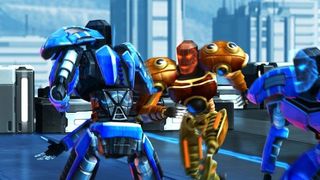
Coinciding with the announcement of Frozen Endzone by Mode 7 Games , I've had an unusually detailed, information-packed talk with the Ian Hardingham (Lead Designer, Lead Programmer, Joint Managing Director) and Paul Taylor (Joint Managing Director, Writer, Musician), with comments sprinkled in from Endzone's lead animator and lead artist.
Read on for a comprehensive look at what to expect from this curious combination of futuristic football, turn-based strategy, and robot violence.
Visit Frozen Endzone's page on Steam Greenlight .
PCG: Why did you decide to apply your simultaneous turn-based template to a futuristic sports game?
Ian Hardingham, Lead Designer and Lead Programmer: Sports games often display three design facets that are really attractive to me: short play sessions, emergent randomness, and the building of a strong relationship between you and your AI opponents.
Sports games don't tend to feel very generative on the surface, but just think about how quickly a game of FIFA or a pool frame becomes completely unique. For pool it's directly after the break. As for the relationship with your opponents—I presume anyone who's played Mario Kart joins me in having some extremely detailed and unhealthy opinions about Donkey Kong and Luigi. Luigi, especially, would not be welcome in my home.
And I just love the form of simultaneous turn-based. It's unique in allowing you to make decisions in a relaxed manner, but then having extremely visceral action based on those decisions.
PC Gamer Newsletter
Sign up to get the best content of the week, and great gaming deals, as picked by the editors.
What have you learned from Frozen Synapse that's informing your approach to Endzone?
Hardingham: I learnt a lot from Frozen Synapse, but I think the main thing that Endzone is trying to do differently is to require a bit less concentration. In FS it's very easy to make a critical mistake if you aren't paying attention to the details. With Endzone you can be as creative as you can in FS without getting punished for being a bit free-form.
Paul Taylor, Joint Managing Director, Writer: We're focusing a lot on making outcomes exciting to watch. I think it's occasionally hard for someone who is just a casual observer of Frozen Synapse to really understand what's going on, but in Frozen Endzone you are basically creating this insanely exciting piece of very readable action with your moves.
So, you're plotting out the positioning and actions of a robot team. Are the robots modifiable? Are they asymmetrical, do they have stats like a Madden or FIFA player might, or are they drawn from pre-built classes?
Hardingham: They have stats like speed, strength, elusiveness, catching radius—that sort of thing. You'll also be able to personalize your team with loads of bolt-on pieces of "armor." I also want to get a facial-expression editor in the game so you can have a really high degree of control over some aspects of your players.
Will any asymmetries exist between the teams themselves beyond player stats?
Hardingham: In single-player, the AI teams will mainly be differentiated by their tactical styles more than specific robot composition. In general though, Endzone follows Synapse's lead on this—an even playing field where the decisions you make on the field are far more important than anything else.
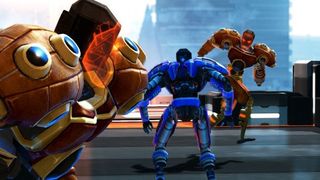
And how many players are on the field per team?
Hardingham: Usually five.
Are there designated starting positions for the players before each play, like conventional sports?
Hardingham: One of the keys to Endzone is that each play has not just randomly-generated terrain, but also procedural placing of the players. To go back to a previous point, and use NFL football as an example: it doesn't take long after the snap until the field is effectively unique, but I didn't like everyone starting in the same or a selected position. That tends to make the set of decisions you make at the start of a play always very similar—and that's one of the things I most want to get away from in our games. It's something I emphasised with FS too: I want starting a new game to be very exciting—just like picking up a new hand at poker or Bridge. It's different every time, and it immediately gives you unique decisions to make.
"I think perma-death particularly is one of the most important design tools out there—it can completely transform a game."
In general, if you increase a stat on a player I want it to be a big change, not a small one. In a lot of sports games you're adding 0.003 percent speed to someone when you upgrade them. I want to go down a more Deus Ex route where after making only a couple of decisions you have a very specific player.
“A more Deus Ex route”—should we think of the robot upgrades as augmentations? How will these upgrades work in multiplayer?
Taylor: So, in multiplayer, augmentations will be aesthetic only. We're pretty set on that. We want this to be a balanced, competitive multiplayer game in the classic sense, and upgrades make that hard. In single-player, it's really too early to tell. I think it would be so easy for us to say "yes, you can have amazing pneumatic legs that buff your speed!" but the way Ian designs games is that he's extremely careful about preserving the core gameplay. So, we need to get heavily into this and feel it out before we start making commitments to exactly the kinds of upgrades you'll be getting. That's very key to our design process.
Let's talk about how a match plays out. What are the decisions the player makes through a round?
Hardingham: It's a highly territorial game where both players have to gamble on what they think their opponent is going to do, and also outwit them by better analyzing the randomly-generated terrain and their players' positions and abilities. There's no right or wrong way to play the game—any plan can succeed if the enemy doesn't defend it, and any plan can be defeated with the right defense.
The thing I'm most proud of is the sheer creativity you can bring to every play. You've got freedom to use your players in any way to get a path for the ball from the quarterback to the Endzone. And if everything goes wrong, never mind—just click the next-game button and you've got a brand new situation to design a play for. Each match usually takes about five minutes to play, but those five minutes are packed with the kind of difficult, interesting, creative decisions you saw in Frozen Synapse. FS was already pretty quick, but I've tried to distill it even further—I never want you to have a boring decision to make, or to face the same decision twice.

So you're sort of the coach of these players and the offensive and defensive coordinator rolled into one role, is that right?
Taylor: It's kind of a "mega-coach" role. In single-player, I do want to have supporting characters on your team, so you will almost certainly get some advice here and there. NFL coaches have lots of personality and tend to be divisive figures so, in the single-player story, I think it will be interesting to play someone like that. If you're playing a coach role in a single-player sports game, it tends to be pretty faceless (like Speedball) or just a cypher for a barrage of stats (Madden: Head Coach). I want to do something narratively meaningful within both the sports genre and the roguelike structure Ian's going to create. That's going to be... tough but interesting!
Is your “mega coach” a character that you design yourself?
Taylor: I actually really want the coach in single-player to be a defined character with a story this time around. I think that's an interesting way of getting into the world of the game, so I expect that's the route we'll be taking. In multiplayer, we're looking for player-controlled teams to have their own personality, so there will be customization options. How that will pertain precisely to the coach... we don't know yet!
Ian, what does Paul mean when he says you're creating a “roguelike structure” for Endzone?
Hardingham: The key aspects of "roguelike" for me are: short play sessions, perma-death, and highly generative content. In a global sense I want Endzone to be different every time you pick it up, and be able to achieve something new quickly after starting a session. I think perma-death particularly is one of the most important design tools out there—it can completely transform a game. So many games really obfuscate their failure conditions—"finish in the bottom half of three races in a row," "get shot some indeterminate amount of times"—I believe clear failure conditions are the key to allowing players to get creative with the metagame. Once you understand the rules, you can start imagining ways to bend them.
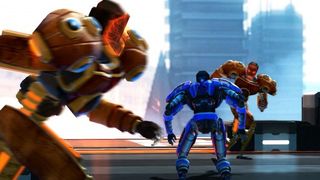
Speaking of rules more literally: are there penalties? Are there referees? Can I throw a referee off the top of a building with my strong robot hands?
Hardingham: I think that in some sports games there's a tendency to a "kitchen sink" approach of mechanics—trying to crowbar everything that exists in a real sport into the game, no matter whether it's appropriate or not. I don't really like that very much—I think we'd rather make a specific game which we really believe in, and then add the other stuff as purely aesthetic concerns. So for example: we want to have a ref running around the field for visual humor, but he won't have any funny rules especially for him. Penalties and injuries are examples of things which are big in real-life sports which don't fit into Endzone specifically—but we'll likely use them for world-building outside the matches themselves.
Can you walk me through an example series of plays?
Hardingham: I'm playing against our bearded level designer and real-life knife-thrower/salsa-dancer Bin. We start a match and I see the brand new generated level layout. I'm seeing quite a dense map with a lot of terrain creating narrow corridors. I'm on offense, and I can see that Bin's team has speed, whereas mine is more built around power-blocking.
It looks like I'm going to need to set up a blocking corridor to get to the endzone, and for that I'm going to need a long-ish first turn.
In Endzone, the offense dictates how long the first turn (called "the snap") is. A long first turn usually favors the offense as it gives more time for my players to get into position and will be harder for the defense to predict. On the other hand, if the defense suspects I'm going to take a "long drop" he may send some blitzers—if he does that I may get sacked before I get a chance to get a second turn.
"I think that in some sports games there's a tendency to a 'kitchen sink' approach of mechanics—trying to crowbar everything that exists in a real sport into the game."
The most important thing in turn one is to analyze the terrain and player placement to work out how I can control the territory I want. The first thing I look at is where I can control without any danger of the defense getting there first. Then I need to look at what I can achieve if I can predict what my opponent is going to do. I see a lane I like the look of and send my guys to positions to block it. I need options in case Bin guesses what I'm doing though, so I send a receiver to the other side of the field as a safety valve. Finally I send my QB running away from possible danger while staying behind the line of scrimmage.
I press commit. Bin still hasn't finished his turn because he's trying to fix the automatic M&M dispenser he got for Christmas, but I hurry him up and he commits.
TURN 1 OUTCOME: Damn it. Bin hasn't sacked me, which is a good start, but he managed to get one of his guys into the lane I was hoping to block off, so any hope of an easy score is gone. I can now basically do anything, but whether it succeeds or not depends on what Bin does. He's got one defender covering two receivers though—so I can force him to guess and hopefully guess wrong. I order up a throw to one of my guys and commit.
TURN 2 OUTCOME: Damn it. Bin's defender went for the wrong receiver, but he managed to move another guy to be in range. He can easily get to my receiver but I have one guy to block for him. Right, I'm going to try to bluff Bin. I'm going to send my receiver directly through where his defender currently is, assuming he'll move him to intercept me somewhere else. My blocker is just a decoy—let's hope he's a good one.
TURN 3 OUTCOME: Damn it! Bin moved his guy, but found a position I hadn't thought of which still covers my route. Big tackle and the play's over—no score for me.
Now we play the same map but with myself on defense and Bin on offense. I can still force a draw if I can just stop Bin scoring...
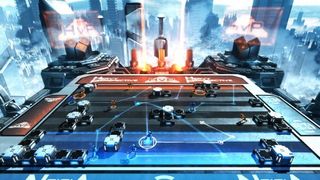
So like Synapse, there's a focus on mapping out possible outcomes, managing territory, and risk-taking. It's also evident from the trailer that while the guns are gone, there's plenty of tackling and collision. How violent of a game will Endzone be?
Taylor: If you're in the audience at a sporting event, and you see a big tackle, the crowd gets this charge running through it: a kind of thrill. That's the feeling we want to have in Endzone, so we have these huge crunching tackles, with robots getting flung around and slammed to the ground. Animation is a very big part of this game, so you'll see lots of cool stuff as a payoff for doing well.
When you go for much more violent stuff, you either get into silly territory or—if it's too realistic—you get a kind of sadistic darkness creeping in. We had an animation of one player beating another one up while he was lying on the ground, and our lead animator Martin Binfield is so good that it was actually a bit stomach churning, like some horrible footage from a riot! It didn't seem to fit with the rest of the game, so we're moving away from that a little bit. So, big huge tackles, but no death or explosions. Dismantlement... that should really be a word.... is something that's still possible but unlikely, I think.
How difficult do you expect it to be to animate that? Are you using motion capture? Are dynamic elements like ragdoll a part of your animations?
Martin Binfield, Lead Animator: It is tricky, but in unexpected ways. On one hand, there's the nitty-gritty low-level systems of game animation. This involves making sets of animations so that a player can throw or catch a ball at any time in any direction while running at different speeds and looking at any other player. On the other hand there's the big set-piece animations like the takedowns and the celebrations which are more self contained big moments. Also, we're aiming for a more exaggerated feel than regular football so we'll be making the players do things that you couldn't get away with inflicting on a human meatbag mocap actor.
The whole approach of the animation system is to be deterministic—that is, the play is evaluated and then the replay is constructed based on what happened. This means we don't need real-time dynamics as all the animations will be pre-calculated. In cases where two or more players interact the system uses 'paired' animations which are hand-crafted to work as one.

Let's talk more about Endzone's art style. How'd you settle on the aesthetic? It's less abstract than Synapse.
Richard Whitelock, Lead Artist: The endgame for Frozen Endzone's art is to communicate a large amount gameplay related information and reward that play with satisfyingly brutal outcomes, not just for the players but also any spectators who are watching. There is a careful balance to be struck here. I want the play and the outcomes to be exciting, satisfying and comprehensible from closeup on a PC screen and from the opposite end of a bar or event. Walking this line involves what I think of as a layering process. Repeatedly stripping the visuals down to the bare elements, then re-applying those elements from the larger broad brushstrokes to the smaller details and flourishes.
"We had an animation of one player beating another one up while he was lying on the ground..."
As a spiritual sequel to Frozen Synapse, Endzone has an array of iconography to draw from and many of these are re-incorporated as visual themes, albeit rendered with a greater solidity than Synapse's neon-like abstracts. There are also some new icons, some of which are intended to reference football, or at least an ultra-refined, extreme version of football. Wherever possible the art in Endzone is intended to communicate or identify a gameplay element, from the color of the bespoke shaders and lighting passes to the shapes of environment elements, plans or overlayed FX. There are still many exciting things to add, refine and optimize.
I'm curious if—and if so, to what extent—Endzone will include financial management. Does a team get money or another resource from winning? Do you have to pay to repair players? Can you buy free agents? Beyond that, what's the ultimate goal of a single-player game? Is there a championship? Do you have a playoff structure?
Taylor: These two questions are probably a bit too far into specifics of something that isn't designed yet for us to answer, I'm afraid—sorry about that! We can definitely follow-up on single-player stuff with you once we've got some design decisions locked down, but for us, single-player development will mostly start after the multiplayer beta. We don't want to start promising things that may not happen.
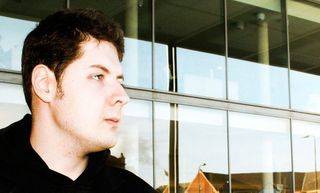
No sweat. Frozen Endzone is on Greenlight —does this mean you're skipping crowdfunding?
Hardingham: Our approach with Frozen Endzone is pretty much the same as FS. We want to do a pre-order beta which is basically a fairly finished and polished multiplayer and single-player skirmish game that, we hope, you'd be happy to buy as a finished product. Then we get to hear everyone's feedback and iterate anything which isn't working, while having the budget to go all out on making an awesome single-player. I love that people are so supportive of indie games that they're willing to invest before the product is finished (or even started), but I feel most comfortable personally to be able to give them something great right from the start. Especially since so many people supported us to such a large extent with Frozen Synapse.
Taylor: Exactly: we owe it to our community and everyone else to show them that we can do before we ask for their money again. If people like the idea and want to support the game now, we are asking them to vote on Steam Greenlight and join that community. We would much rather have an excited, wider community around the game during development than ask for money upfront.
Thanks, guys. Looking forward to it.

Evan's a hardcore FPS enthusiast who joined PC Gamer in 2008. After an era spent publishing reviews, news, and cover features, he now oversees editorial operations for PC Gamer worldwide, including setting policy, training, and editing stories written by the wider team. His most-played FPSes are CS:GO, Team Fortress 2, Team Fortress Classic, Rainbow Six Siege, and Arma 2. His first multiplayer FPS was Quake 2, played on serial LAN in his uncle's basement, the ideal conditions for instilling a lifelong fondness for fragging. Evan also leads production of the PC Gaming Show, the annual E3 showcase event dedicated to PC gaming.
Most Popular








